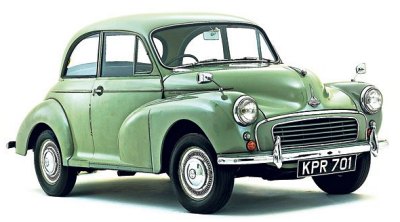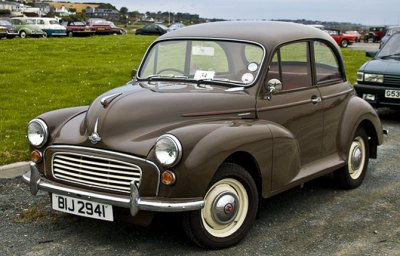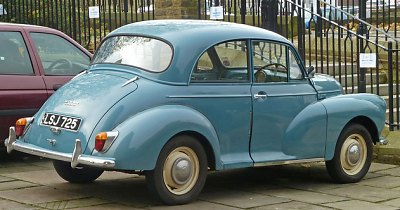 11 years before creating
the legendary Mini, Sir
Alexander Issigonis designed another great small car. It was Morris
Minor. The Minor was neither as small nor as revolutionary as Mini. It
was a more conventional front-engined rear-wheel drive saloon, but it
was engineered with much the same philosophy – simple, reliable,
affordable and good to drive. These qualities let it captured more than
1.3 million units of sales in a long life of 23 years, making it the
most popular British car before Mini. Even today, it still enjoys an
iconic status. There are countless of Morris Minor clubs all over the
world, proving its popularity never dies.
The Minor might be small, but its exterior was strongly influenced by Detroit motors of the time. Its sperm-whale-like bonnet enclosed enough space for a big V8 or a tall straight-six, but ridiculously a small four-cylinder motor sat there, leaving two-third of the engine compartment volume unused. However, that was probably the only nonsense feature of the car. Elsewhere, it was sensibly engineered. Unusual for its time, it employed monocoque construction to cut weight and enhance body strength. While the rear end was suspended by conventional live axle and elliptic leaf springs, the front got independent suspension by torsion bars, which was quite advanced for an affordable car. Even better was the use of rack-and-pinion steering, whose movement was light and accurate. In addition to a light clutch and easy gearshift, the Minor was always praised for good road manner. Its handling was agile, safe and predictable. It offered more driving fun than its limited performance suggested. Moreover, it was easy to drive and park. No wonder in later years it was widely used by driving schools.  In fact, the Minor was used for a variety of applications.
Beside 2-door and 4-door saloon body it was also offered in the form of
convertible, van and pickup truck. It was used as police cars,
ambulances, post office vans, fire fighters, caravans etc., more
versatile than you can imagine.
Being an entry-level 4-seater the Morris Minor inevitably put fuel economy on higher priority than performance. In the beginning it was launched with a 918 cc side-valve four-cylinder engine producing only 29.5 hp, quoting a top speed of 62 mph and zero to sixty acceleration in a time close to infinity. When Morris merged with its rival Austin to form BMC, it got the latter's new A-series overhead-valve engine, initially 803 cc and 30 hp, then 948 cc and 37 hp. The latter was also the launch engine on Mini. In 1962, the ultimate 1098 cc engine made debut, offering 48 hp and 75 mph top speed. 0-60 mph was finally countable in 25 seconds. Its drivability was greatly improved. The car would carry on for nearly a decade without much mechanical improvement. Although it did not last as long as Mini, its ancient look managed to crack into the space-age 1970s, at which time it looked at odds beside new cars like Citroen SM, Maserati Bora or De Tomaso Pantera.  |